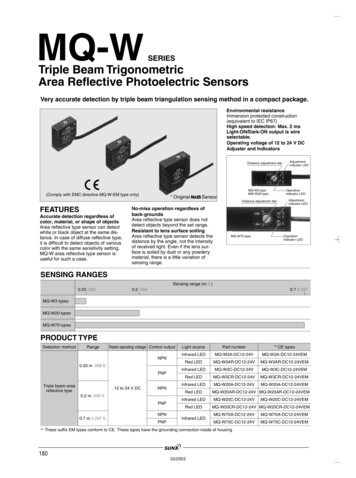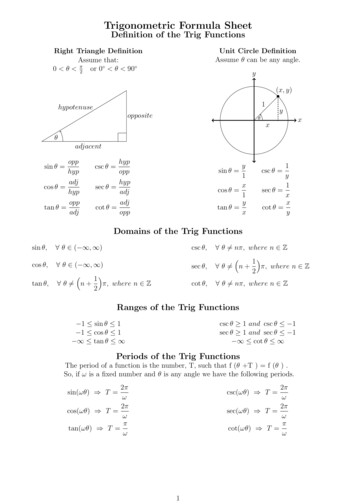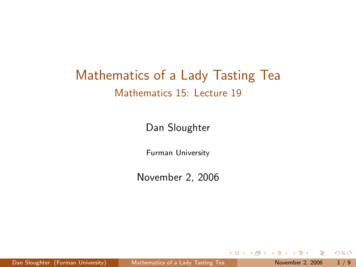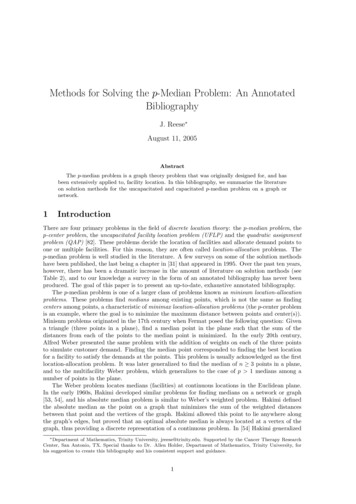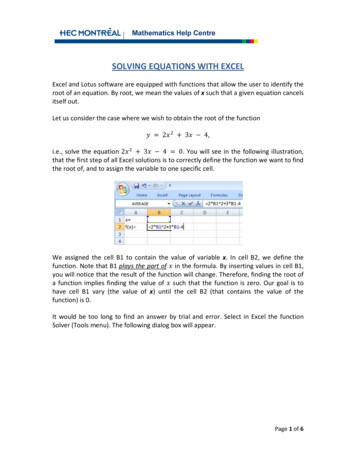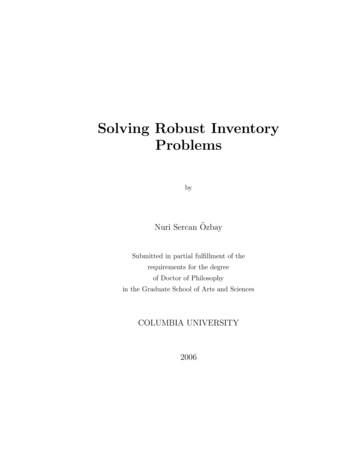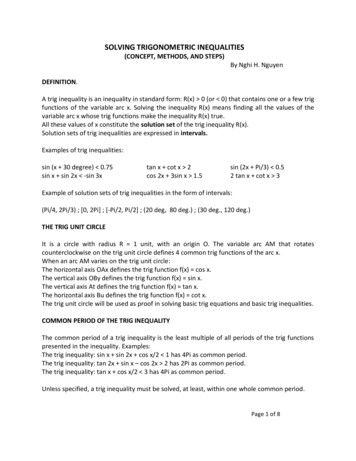
Transcription
SOLVING TRIGONOMETRIC INEQUALITIES(CONCEPT, METHODS, AND STEPS)By Nghi H. NguyenDEFINITION.A trig inequality is an inequality in standard form: R(x) 0 (or 0) that contains one or a few trigfunctions of the variable arc x. Solving the inequality R(x) means finding all the values of thevariable arc x whose trig functions make the inequality R(x) true.All these values of x constitute the solution set of the trig inequality R(x).Solution sets of trig inequalities are expressed in intervals.Examples of trig inequalities:sin (x 30 degree) 0.75sin x sin 2x -sin 3xtan x cot x 2cos 2x 3sin x 1.5sin (2x Pi/3) 0.52 tan x cot x 3Example of solution sets of trig inequalities in the form of intervals:(Pi/4, 2Pi/3) ; [0, 2Pi] ; [-Pi/2, Pi/2] ; (20 deg, 80 deg.) ; (30 deg., 120 deg.)THE TRIG UNIT CIRCLEIt is a circle with radius R 1 unit, with an origin O. The variable arc AM that rotatescounterclockwise on the trig unit circle defines 4 common trig functions of the arc x.When an arc AM varies on the trig unit circle:The horizontal axis OAx defines the trig function f(x) cos x.The vertical axis OBy defines the trig function f(x) sin x.The vertical axis At defines the trig function f(x) tan x.The horizontal axis Bu defines the trig function f(x) cot x.The trig unit circle will be used as proof in solving basic trig equations and basic trig inequalities.COMMON PERIOD OF THE TRIG INEQUALITYThe common period of a trig inequality is the least multiple of all periods of the trig functionspresented in the inequality. Examples:The trig inequality: sin x sin 2x cos x/2 1 has 4Pi as common period.The trig inequality: tan 2x sin x – cos 2x 2 has 2Pi as common period.The trig inequality: tan x cos x/2 3 has 4Pi as common period.Unless specified, a trig inequality must be solved, at least, within one whole common period.Page 1 of 8
BASIC TRIG INEQUALITIES.There are 4 main common types of basic trig inequalities:sin x a (or a)tan x a (or a)cos x a (or a)cot x a (or a)a is a given numberSolving basic trig inequalities proceeds by using trig conversion tables (or calculators), then byconsidering the various positions of the variable arc x that rotates on the trig circle.Example 1. Solve the inequality: sin x 0.709Solution. The solution set is given by both trig table and trig unit circle. On the trig unit circle,sin x 0.709 when the arc x varies between Pi/4 and 3Pi/4:Pi/4 x 3Pi/4Pi/4 2k.Pi x 3Pi/4 2k. PiExample 2. Solve:Answer within period 2PiExtended answerstan x 0.414Solution. The solution set is given by the unit circle and calculator. On the trig unit circle, tan x 0.414 when the arc x varies between the values – Pi/2 (or 3Pi/2) and Pi/8.-Pi/2 x Pi/8-Pi/2 k.Pi x Pi/8 k.PiExample 3. Solve:cos (2x Pi/4) 0.5Answer within period PiExtended answerswithin period 2PiSolution. Solution set given by unit circle and calculator:Pi/3 2x Pi/4 5Pi/3Pi/12 2x 17Pi/12Pi/24 x 17Pi/24Example 4. Solve:Answercot (2x – Pi/6) -0.578(within period Pi)Solution. Solution set given by trig circle and calculator:2Pi/3 x – Pi/6 Pi5Pi/6 2x 7Pi/65Pi/12 x 7Pi/12AnswerPage 2 of 8
To fully know how to solve basic trig inequalities, and similar, see book titled:”Trigonometry:Solving trigonometric equations and inequalities” (Amazon e-book 2010)SOLVING CONCEPTTo solve a trig inequality, transform it into one or many trig inequalities. Solving trig inequalitiesfinally results in solving basic trig inequalities.To transform a trig inequality into basic ones, students can use common algebraictransformations (common factor, polynomial identities ), definitions and properties of trigfunctions, and trig identities, the most needed. There are about 31 trig identities, among themthe last 14 identities (from # 19 to # 31) are called transformation identities, since they arenecessary tools to transform trig inequalities (or trig equations) into basic ones. See bookmentioned above.Example 5. Transform the inequality sin x cos x 0 into a product.Solution.sin x cos x sin x sin (Pi/2 - x) 2sin Pi/4.sin (a Pi/4) 0Use Sum into Product Identity, #28Example 6. Transform the inequality sin 2x – sin x 0 into a productSolution.sin 2x – sin x 2sin x. cos x – sin x sin x (2cos x – 1) 0Trig identity & common factorExample 7. Transform (cos 2x 1 sin x) into a product.Solution.cos 2x – 1 – sin x 01 – 2sin 2 x – 1 – sin x 0-sin x(2sin x 1) 0(Replace cos 2x by 1 – 2sin 2 x)Important Note. The transformation process for the inequality R(x) 0 (or 0) is exactly thesame as the transformation process of the equation R(x) 0. Solving the trig inequality R(x)requires first to solve the equation R(x) 0 to get all of its real roots.STEPS IN SOLVING TRIG INEQUALITIESThere are 4 steps in solving trig inequalities.Step 1. Transform the given trig inequality into standard form R(x) 0 (or 0).Example. The inequality (cos 2x 2 3sin x) will be transformed into standard form:R(x) cos 2x – 3sin x - 2 0Page 3 of 8
Example. The inequality (sin x sin 2x - sin 3x) will be transformed into standard formR(x) sin x sin 2x sin 3x 0.Step 2. Find the common period . The common period must be the least multiple of the periodsof all trig functions presented in the inequality. The complete solution set must, at least, coverone whole common period.Example. The trig inequality R(x) cos 2x – 3sin x - 2 0 has 2Pi as common periodExample. The trig inequality R(x) sin x – cos x/2 - 0.5 0 has 4Pi as common period.Example. The trig inequality R(x) tan x 2 cos x sin 2x 2 has 2Pi as common period.Step 3. Solve the trig equation R(x) 0If R(x) contains only one trig function, solve it as a basic trig equation.If R(x) contains 2 or more trig functions, there are 2 methods, described below, to solve it.a. METHOD 1. Transform R(x) into a product of many basic trig equations. Next, solvethese basic trig equations separately to get all values of x that will be used in Step 4.Example 8. Solve:cos x cos 2x - cos 3x(0 x 2Pi)Solution. Step 1. Standard form: R(x) cos x cos 2x cos 3x 0Step 2. Common period: 2PiStep 3. Solve R(x) 0. Transform it into a product using Sum to Product Identity:R(x) cos x cos 2x cos 3x cos 2x (1 2cos x) 0.Next, solve the 2 basic trig equations f(x) cos 2x 0 and g(x) (1 2cos x) 0 to get all valuesof x within the period 2Pi. These values of x will be used in Step 4.Example 9. Solvesin x sin 2x -sin 3x(0 x 2Pi)Solution. Step 1:sin x sin 2x sin 3x 0Step 2: Common period 2Pi.Step 3. Solve R(x) 0. Transform it into a product using trig identity:R(x) sin x sin 2x sin 3x sin 2x (2cos x 1) 0Next, solve the 2 basic trig equations f(x) sin 2x 0 and g(x) 2cos x 1 0. The found valuesof x will be used in Step 4.Page 4 of 8
b. METHOD 2. This method transforms a trig inequality with 2 or more trig functions into atrig inequality having only one trig function (called t) as variable. Next, solve for t from this trigequation, as a basic trig equation. Then, solve for x from these values of t. The common trigfunctions to be chosen as function variable are: sin x t; cos x t, cos 2x t; tan x t; andtan x/2 t.Example 10. Solve:3sin 2 x sin 2x cos 2 xSolution. Divide both sides by cos 2 x (cos x not equal 0; x not equals Pi/2). Let tan x t.3 t 2 – 2t - 1 0This is a quadratic equation having 2 real roots: 1 and -1/3Next, solve the 2 basic trig equations: tan x t 1 and tan x t -1/3Example 11. Solvetan x 2 tan 2 x cot x 2(0 x Pi)Solution. Let tan x t. (with t not equal Pi/2; t not equal Pi)t 2t 2 1/t 2t 2 (1 2t) 1 2t(2t 1) (t 2 – 1) 0Let tan x tMultiply both sides by tFactor out (2t 1)Next, solve the 3 basic trig equations: (2tan x 1) 0; tan x -1; tan x 1.Step 4. Solve the trig inequality R(x) 0 (or 0). Then express the solution set in the form ofintervals.Based on the found values of x from Step 3, solve, algebraically, the trig inequality R(x) 0 (or 0) by separately solving each basic trig inequality f(x), g(x) ., and then by setting up a sign sable(sign chart).Example 12. Solve:sin x sin 3x - sin 2xSolution. Step 1. Standard form:R(x) sin x sin 2x sin 3x 0Step 2. Common period 2PiStep 3. Solve R(x) 0. Transform R(x) into a product, using Trig Identity # 28;R(x) 2sin 2x (2cos x 1) 0(0 x 2Pi)Next, Solve the basic trig equation: f(x) sin 2x 0. The solution arcs x are: 0, Pi/2, Pi, 3Pi/2, 2Pi.Using the trig unit circle as proof, determine the variation of f(x) from 0 to 2Pi with ( ) and (-)values:Page 5 of 8
------f(x)0 00 00Solve g(x) 2cos x 1 0. The solution arcs are: 2Pi/3, 4Pi/3. Determine the variation of g(x)from 0 to 2Pi with ( ) and (-) ------------g(x) 00 Step 4. Solve the inequality R(x) 0 by the algebraic method.First, create a sign table, in which the top line figures all values of x obtained from Step 3, andprogressively varying from 0 to 2Pi. These x values create various intervals between them.Next, determine the variations of f(x) and g(x) on the second and third line of the table, byputting or – sign inside each corresponding interval.The last line of the table figures the variation of R(x) that has the resulting sign of the productf(x).g(x). In this Example 12, all the intervals where R(x) is negative ( 0) constitute the solutionset of the trig inequality R(x) 0.THE SIGN TABLE (SIGN CHART)x: -----------------------------------------f(x): 0 00 ------------------g(x) : 00 ----------------R(x) : 0 00 00 00YesYesYesSolution set of the trig inequality R(x) 0: (Pi/2 , 2Pi/3) and (Pi , 4Pi/3) and (3Pi/2 , 2Pi)NOTE 1. The approach to determine the variations of f(x) and g(x) is exactly the same approachin solving basic trig inequalities, basing on the positions of the variable arc x that rotates on thetrig unit circle.NOTE 2. THE GRAPHING METHODSolving trig inequalities is a tricky work that often leads to errors/mistakes. After solving triginequalities by the algebraic method, you can check the answers by graphing the trig functionR(x) by graphing calculators.Page 6 of 8
You can also use graphing calculators to directly solve the trig inequality R(x) 0 (or 0). Thismethod, if allowed, is fast, accurate and convenient. To know how to proceed, read the lastchapter of the book mentioned above (Amazon e-book 2010).EXAMPLES ON SOLVING TRIG INEQUALITIESExample 13. Solve:(2cos x – 1)/(2cos x – 1) 0(0 x 2Pi)Solution.Step 1: The function F(x) f(x)/g(x) (2cos x 1)/(2cos x – 1) 0 is undefined when x 2Pi/3and x 4Pi/3.Step 2. Common period 2Pi.Step 3. Solve f(x) 2cos x – 1 0 cos x ½ x Pi/3 ; x 5Pi/3Solve g(x) 2cos x 1 0 cos x -1/2 x 2Pi/3 ; x 4Pi/3Step 4. Solve F(x) 0, algebraically, by setting up the sign chart (sign table)xI0Pi/32Pi/34Pi/35Pi/32Pif(x)I 00 ------------------------g(x) I 00 wer or solution set: (Pi/3 , 2Pi/3) ; (4Pi/3 , 5Pi/3).Example 14. Solve:tan x cot x -4(0 x Pi)Solution.Step 1. Transform the inequality into standard form;sin x/cos x cos x/sin x 4 2/sin 2x 4 0F(x) 2(2sin 2x 1)/sin 2x 0undefined when x kPi/2 and x kPiStep 2. The common period of F(x) is Pi since the period of sin 2x is Pi.Page 7 of 8
Step 3. First, solve f(x) 2sin 2x 1 0sin 2x -1/2 x 7Pi/2 ; x 11Pi/12Next, solve g(x) sin 2x 0 sin 2x 0 x 0 ; x Pi/2Step 4. Solve F(x) 0, algebraically, by setting up the sign chart (sign table):xI0Pi/27Pi/211Pi/2Pif(x)I 00 -g(x) I0 ---F(x)IIINoII YesINoIYesIIAnswer or solution set: (Pi/2 , 7Pi/2) ; (11Pi/12 , Pi)(This article was written by Nghi H. Nguyen, the co-author of the newDiagonal Sum Method for solving quadratic equations)Page 8 of 8
SOLVING TRIGONOMETRIC INEQUALITIES (CONCEP T, METHODS, AND STEPS) By Nghi H. Nguyen DEFINITION. A trig inequality is an inequality in standard form
